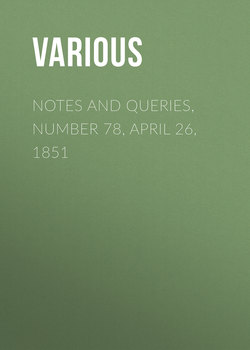Читать книгу Notes and Queries, Number 78, April 26, 1851 - Various - Страница 3
Notes
THE ACADEMIES OF SIR FRANCIS KYNASTON AND SIR BALTHAZAR GERBIER
ОглавлениеAmong the many interesting associations connected with old Covent Garden and its neighbourhood, we ought not to overlook Sir Francis Kynaston's "Museum Minervæ."
In the year 1635, King Charles the First granted his letters patent to Sir Francis Kynaston, "Esquire of the body to his Majesty," whereby a house in Covent Garden, which Sir Francis had purchased, and furnished with books, manuscripts, musical and mathematical instruments, paintings, statues, antiques, &c., was appropriated for ever as a college for the education of the young, nobility, and others, under the name of the "Museum Minervæ." Sir Francis Kynaston was made the governor with the title of "regent;" Edward May, Thomas Hunt, Nicholas Phiske, John Spidell, Walter Salter, Michael Mason, fellows and professors of philosophy and medicine, music, astronomy, geometry, languages, &c. They had power to elect professors also of horsemanship, dancing, painting, engraving, &c.; were made a body corporate, were permitted to use a common seal, and to possess goods and lands in mortmain. (Pat. 11 Car. pt. 8. No. 14.) In the following year, 1636, was published, dedicated to the "Regent and Professors," The Constitutions of the Museum Minervæ; giving an Account of an Academy for teaching chiefly Navigation, Riding, Fortification, Architecture, Painting, and other useful Accomplishments.
The "Museum" seems to have been highly patronised, for we find that on the 27th February, 1635 (the year of its foundation), Prince Charles, the Duke of York, and the Lady Mary their sister, honoured it with their presence to witness a masque, entitled "Corona Minervæ," which was written and prepared for the occasion by Sir Francis Kynaston. This masque was, I believe, printed in the year of its production, but I do not find it mentioned in the last edition of the Biographia Dramatica.
Mr. Cunningham, in his Handbook of London, mentions (p. 42.) that
"Sir Francis Kynaston, the poet, was living in Covent Garden in 1636, on the east side of the street towards Berrie" (Bedfordbury).
And again, in his notice of Bedford Street (p. 44.), he says, Sir Francis resided "on the west side in 1637." Both these entries refer to the same residence—a noble mansion, built in the year 1594, which, after being inhabited by several important families, finally passed into the possession of Sir Francis Kynaston, who altered and adapted it (rebuilding some portions) as the college of the "Museum Minervæ." The ground plan, which is now before me, exhibits a well-arranged and commodious building with two fronts, one in what is now Bedfordbury, and the other (probably added by Sir Francis) in the street now called Bedford Street. The building, when Sir Francis Kynaston purchased it in 1634, stood in the centre of a large garden. The surrounding streets,—King Street, New Street, Bedford Street, Chandos Street, Henrietta Street, and Bedfordbury, were not commenced building until the year 1637.
The "Museum Minervæ" is not named in Mr. Cunningham's excellent Handbook; but when we take into consideration the enormous amount of information required for a work of the kind, we ought not to blame the author for a few trifling omissions.
Sir Balthazar Gerbier, an enterprising projector of the same century, by profession a painter and an architect, but now scarcely remembered as either, seems to have imitated the "Museum Minervæ" in an academy opened at Bethnal Green in 1649. Here, in addition to the more common branches of education, he professed to teach astronomy, navigation, architecture, perspective, drawing, limning, engraving, fortification, fireworks, military discipline, the art of well speaking and civil conversation, history, constitutions and maxims of state, and particular dispositions of nations, "riding the great horse," &c. Once in each week, at three o'clock in the afternoon, Sir Balthazar gave a public lecture gratis on the various sciences. The lectures were generally advertised in the Perfect Diurnal, and a few curious specimens of these advertisements may be seen in Lysons' Environs of London, ed. 1795, vol. ii. p. 30.
Balthazar Gerbier was born at Antwerp about 1591, came young into England, and was a retainer of the Duke of Buckingham as early as 1613. Upon the accession of Charles the First, he was employed in Flanders to negociate privately a treaty with Spain. In 1628 he was knighted at Hampton Court; and, as he says himself in one of his books, was promised by the king the office of surveyor-general of the works, after the death of Inigo Jones. In 1637 he was employed in some private transactions of state; and on the 13th of July, 1641, he took the oaths of allegiance and supremacy, having a bill of naturalisation. In 1648 he appears to have projected the above-named academy, the failure of which very soon happened. Sir Balthazar then went to America, where he seems to have been very ill treated by the Dutch, and narrowly escaped with his life. He afterwards returned to England, and designed the triumphal arch for the reception of Charles the Second. He died at Hempsted-marshal, in 1667, whilst engaged in superintending the mansion of Lord Craven, and was buried in the chancel of that church.
In conclusion, it may be as well to mention, that, prior to the establishment of the "Museum Minervæ," a committee had been appointed in the House of Lords, consisting of the Duke of Buckingham and others, for taking into consideration the state of the public schools, and method of education. What progress was made in this inquiry is not known, but in all probability the academies of Sir Francis Kynaston and Sir Balthazar Gerbier owed their origin to the meetings of this committee.
Edward F. Rimbault.
